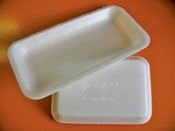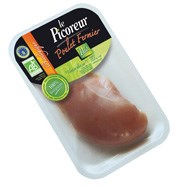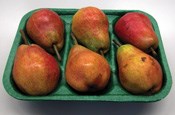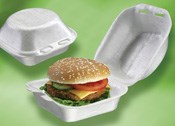Foamed PLA Shows Promise In Biodegradable Meat Trays
Foamed food trays made of polylactic acid (PLA) resin, the corn-based biopolymer, have a commercial toehold in Europe and are undergoing market tests here.
Foamed food trays made of polylactic acid (PLA) resin, the corn-based biopolymer, have a commercial toehold in Europe and are undergoing market tests here. They are used to package meat or fish at the Finiper SpA super-market chain in Italy and organic chicken or duck from Bodin Industries in France. PLA meat trays also appeared in a market test last summer at Wild Oats markets in Colorado. The test was interrupted when Wild Oats was bought by Whole Foods but was recently resumed.
Coopbox SpA in Reggio Emilia, Italy, a major producer of foam food packaging, introduced the first foamed PLA trays, called Naturalbox, in 2005 for meat, fish, or poultry. Cryovac Inc. in Reading, Pa., was second to commercialize PLA foam trays last summer. Its NatureTray is aimed at fresh meat. Both processors use a special foam grade of NatureWorks PLA from NatureWorks LLC.
Coopbox reduces PLA’s density by about 75% from its original 1.24 g/cc to around 0.30 g/cc in thermoformed trays. Coopbox says it foams PLA using “conventional gases” such as nitrogen, CO2, or butane. A Coopbox European patent application (EP 1528079; WO 2005/04/2627) describes foaming PLA with nitrogen, CO2, or mixtures of the two and no other foaming aids or thickening additives. Coopbox’s deepest tray is about 0.875 in., but the firm is working on deeper draws.
Cryovac won’t specify the density of its NatureTray, but has said its goal is to achieve the same density as PS foam (about 0.05 to 0.08 g/cc), though it hasn’t reached that yet. NatureTray comes in five shapes, the deepest being 1.31 in.
Dyne-A-Pak Inc., Laval, Que., has also developed a foamed PLA meat tray, which it expects to test market next year. The trays are produced on a full-scale PS foam line using a special cooling screw designed for PLA. The trays have a density of 0.05 to 0.06 g/cc.
More biopolymer foams
A special grade of Mater-bi starch-based biodegradable resin from Novamont in Italy is also being used for foamed food trays in Europe. Sirap Gema SpA in Verolanuova, Italy, makes foamed Ekofoam trays out of Mater-bi to pack delicate fruit like pears for Sainsbury markets in the U.K.
Novamont commercialized the first non-water-soluble Mater-bi grade for foam in 2004. It is foamed with gas rather than chemical blowing agent (CBA). It has the advantage of being backyard compostable, while PLA requires industrial composting.
Foamed Mater-bi trays have a density around 0.10 g/cc vs. 1.28 g/cc for the solid resin. At the recent K 2007 show in Dusseldorf, Germany, Novamont showed a developmental sample of Ekofoam trays laminated during thermoforming to biodegradable Mater-bi barrier film. The commercial target is meat packaging in the U.K. Novamont says it’s also working with a large U.S. packaging company to foam Mater-bi trays.
BASF has developed a new foaming grade of its Ecovio biopolymers, which are blends of BASF’s petrochemical-based Ecoflex biodegradable resin with PLA. The foamable grade, called Ecovio L Foam, uses a high PLA content (>75%) to make a foam flexible enough for a clamshell with a living hinge.
BASF’s goal is to develop a biodegradable resin as a drop-in substitute for PS in existing tandem foam extrusion lines. Density of the foamed Ecovio L trays is 0.08 g/cc but BASF hopes to achieve 0.06 g/cc. BASF is working with a large U.S. food-packaging company and expects to produce commercial quantities of Ecovio L early next year.
Boosting melt strength
The major hurdles in foaming PLA are its low melt strength, high shear sensitivity, and high heat retention, all of which can be addressed with screw and formulation technology. To solve the heat-retention problem, a special cooling screw is needed for the second extruder of a tandem foam line, says Coopbox, which developed its own design.
A commercial solution is available from a U.S. company, Plastic Engineering Associates, which worked with NatureWorks to modify a PS foam cooling screw for PLA. PEA’s Turbo-Screw has rectangular holes through the screw flights at the root, which move melt from the root to the barrel wall for faster cooling and higher output. (Typical cooling screws use slots between flights, not holes.) The root in the first section of the Turbo-Screw gets progressively deeper so that shear heat doesn’t build up. The Turbo-Screw reportedly can produce PLA foam trays with a density of 0.05 g/cc after thermoforming.
The Turbo-Screw is available under license with a production-based royalty. Plastic Engineering Associates says it has sold two licenses for the PLA Turbo-Screw to large and medium-sized producers of foamed food packaging in North America. Two PLA Turbo-Screws have been built so far for R&D.
Additives can be used to remedy PLA’s low melt strength. CESA-extend is a chain-extending additive from Clariant Additive Masterbatches, which was developed to rebuild the molecular weight (or I.V.) of recycled PET, nylon, and polycarbonate. CESA-extend in a PLA carrier can be used at 1% to 4% levels (up to 6% is FDA approved) to increase PLA’s surface tension and viscosity, creating higher cell densities and smaller cells, Clariant says. Clariant displayed samples of Cryovac’s foamed PLA trays at the recent K Show.
Reedy International, Keyport, N.J., is also developing a combination chemical foaming agent and melt-strength enhancer for PLA and PET. Two versions called Safoam RPC-20MS1 and 20MS2 are in customer trials.
Because PLA is a polyester, it’s no surprise that excessive moisture during processing causes hydrolysis and loss of molecular weight. Moisture should be kept below 250 ppm (0.025%), so endothermic nucleating agents like Clariant’s Hydrocerol or Reedy’s Safoam RPC-AS must be formulated not to release moisture as a byproduct of foaming.
NatureWorks’ first foam grade is distinguished by its bimodal molecular-weight distribution. The resin has an amorphous HDT of 120 F, which matches the heat resistance of the trays from Coopbox and Cryovac. NatureWorks will soon commercialize this experimental grade and is working on another with even higher HDT. The object is to reach a high enough HDT to make a foamed package that doesn’t require temperature-controlled storage and would be suitable for use with hot foods.
Some PLA blends already achieve high HDTs. Cereplast in Hawthorne, Calif., blends PLA with a thermoplastic starch in a developmental CPF foam grade, which Cereplast expects to commercialize in early 2008. The material is noteworthy for heat resistance above 200 F. It can be reduced in density by 50% to about 0.32 g/cc, Cereplast says. Unitika Ltd. in Japan is also developing high-heat foam grades of PLA.
Related Content
Reduce Downtime and Scrap in the Blown Film Industry
The blown film sector now benefits from a tailored solution developed by Chem-Trend to preserve integrity of the bubble.
Read MorePart 2 Medical Tubing: Use Simulation to Troubleshoot, Optimize Processing & Dies
Simulation can determine whether a die has regions of low shear rate and shear stress on the metal surface where the polymer would ultimately degrade, and can help processors design dies better suited for their projects.
Read MoreThe Importance of Barrel Heat and Melt Temperature
Barrel temperature may impact melting in the case of very small extruders running very slowly. Otherwise, melting is mainly the result of shear heating of the polymer.
Read MoreMedical Tubing: Use Simulation to Troubleshoot, Optimize Processing & Dies
Extrusion simulations can be useful in anticipating issues and running “what-if” scenarios to size extruders and design dies for extrusion projects. It should be used at early stages of any project to avoid trial and error and remaking tooling.
Read MoreRead Next
People 4.0 – How to Get Buy-In from Your Staff for Industry 4.0 Systems
Implementing a production monitoring system as the foundation of a ‘smart factory’ is about integrating people with new technology as much as it is about integrating machines and computers. Here are tips from a company that has gone through the process.
Read MoreLead the Conversation, Change the Conversation
Coverage of single-use plastics can be both misleading and demoralizing. Here are 10 tips for changing the perception of the plastics industry at your company and in your community.
Read MoreSee Recyclers Close the Loop on Trade Show Production Scrap at NPE2024
A collaboration between show organizer PLASTICS, recycler CPR and size reduction experts WEIMA and Conair recovered and recycled all production scrap at NPE2024.
Read More


























